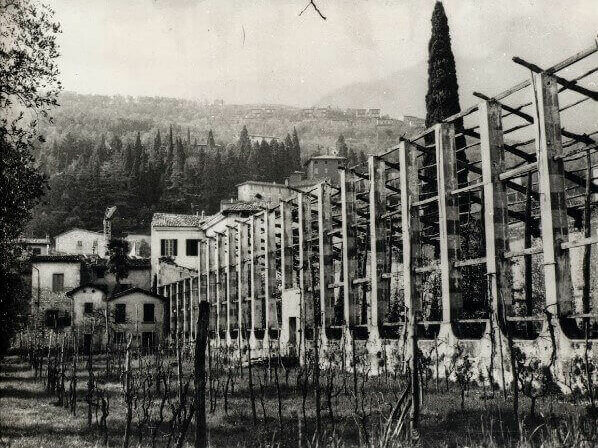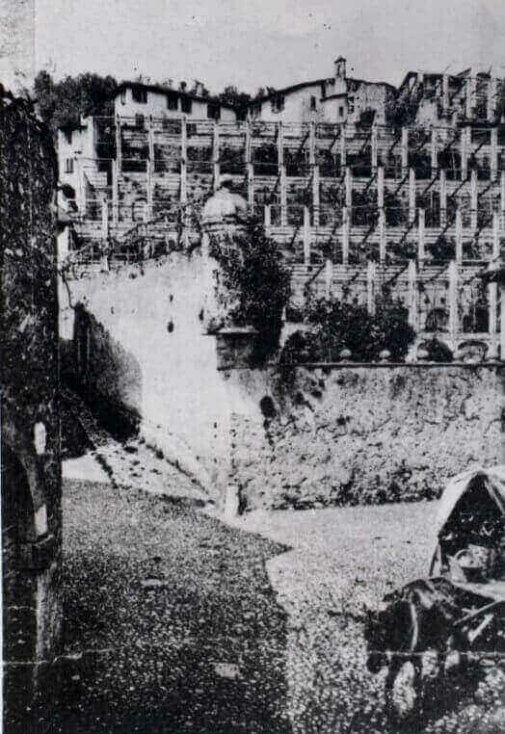LIMONAIE
Lemons first reached Europe in the 11th century, brought by the Arabs to Sicily. Subsequently, lemon groves began to appear in the north, in Liguria, and as early as the 14th century extended as far as Lake Garda. This was documented in the following century by contemporary writers, thanks to the Servite Fathers of Maderno and the Franciscan friars of Gargnano. The Servites cultivated lemons in their convent in Maderno, located in what is now Palazzo Bulgheroniand in the annexed building above, today Villa Caprera. The Franciscans did the same in their Gargnano monastery and this is shown on the bas reliefs depicting the precious fruit, carved on the column capitals in the San Francesco cloister. The climate of upper Garda was particularly mild and favoured intensive cultivation of lemons. At the same time, with its 46° north latitude, the area was also the most northerly in the world for this type of fruit. If temperatures are close to or below 0 °C for several days, the trees die because they have surface roots. For this reason, they had to be protected and tended during the winter in special structures known as lemon houses, built by hand using stone for the three side walls and the tall pillars, and a wood frame for the sloping roof. The lemon houses were installed close to the mountainside, sheltered from the evening winds, and with the open front oriented south east, facing the lake. By tradition, on 25 November, St Catherine’s day, the open side would be closed with wooden planks and windows for the winter. If temperatures dropped, special fires would be lit inside the structure to keep temperatures above 0 °C. The lemon groves were concentrated only in the Brescia district of the upper Garda, the so-called “Riviera on the Riviera”, around Maderno, Gargnano and Limone. There were also groves on the Verona side, but far fewer, from Castelletto di Brenzone to Garda.


The golden age of Garda citrus growing (18th century) was a boon for the modest local economy, because it engaged a large workforce: gardeners, women and children (for the harvesting and selecting), masons, blacksmiths, peasants, and boatmen. From the first flowering in March, lemons were collected continuously, selected by size, arranged in wooden boxes, then transported by lake to the ports of Torbole (for export to northern Europe and up to St Petersburg), or Bardolino and Desenzano, going on to Venice and Milan. Citrus fruits from southern Italy were no match for the Garda product. Exports from the south were heavily penalized by duty levied by the many pre-Unification states through which the fruit travelled. The fortunes of the northern lemon were attributable to the high content of vitamin C it contained, used for medicinal purposes to combat scurvy. Johann Wolfgang von Goethe was fascinated by the landscape so strongly sculpted by these lemon groves, which he noted as he sailed past Limone, during a boat trip from Torbole to Malcesine on 13 September 1786, in one of the legs of his Italian Grand Tour, which he later described in the book Italian Journey(1829). In 1855, the beginning of the end of this trade was triggered by the onset of gummosis, a lethal disease for the trees for which there was no known remedy. Subsequent factors, including competition from lemons from southern Italy, far easier to export after the Unification of Italy (1861), the duty levied at foreign borders, rising labour costs, and the discovery of synthetic citric acid made the crop less profitable. The First World War, with the requisition of metals used in the lemon houses and a series of exceptional winter frosts (1905–1928–1928) marked the end of cultivation and the inevitable abandonment of the structures. Few lemon houses have survived intact and well-preserved, but we can mention those of Gargnano, accessible during the “Giardini d’Agrumi” event (www.terresapori.it); “La Malora”(www.limonaialamalora.it); Maderno (Piazzale Salvo D’Acquisto); Toscolano (Parco Bernini); “Prà dela Fam” in Tignale (www.tignale.org); “Castel”, in Limone (www.visitlimonedelgarda.com); in Torri del Benaco (www.museodelcastelloditorridelbenaco.it).
" Zardini de zedri, naranzari, et pomi damo infiniti:lochi, concludendo, amenissimi, gentili et soavi, da sir habitati sempre"
year - 1483 Marin Sanuto
" ... sotto al detto giardino poi evvi più al basso discendendo un verdissimo, e folto boschetto di aranzi con alcuni lauri interministi bello, e riguardevole molto, sito tanto nobile, e dilizioso, che al Conte primieramente, e poscia a tutti noi ne pareva esser nelli orti delle Esperidi. Fummo accolti benignamente, e con allegro volto dal buon prete, il quale anco cortesemente ci condusse per tutto il suo bellissimo luogo, donandoci de' suoi odoriferi frutti, e così considerato diligentissimamente dal Conte, e piacciutogli senza fine, e con esso noi consigliandosi di ciò, che a far avevano, per il rimanente di quel giorno, al fine conchiudemmo, che meglio era, che ivi sotto un'ombroso, e grande albero di limoni (allor di fiori, e frutti carico) che accanto a bel fonte era, dimorassimo fin al tramontar del sole; e doppoi venirci così passo passo sulla sera si ascende da cinquanta scaglioni fin ad altra pià alta grotta, dove entro evvi la chiesetta di S. Giorgio, dalla quale, come da munitissimo castello... "
year 1552 - Silvan Cattaneo
Indirizzo
via Lungolago G. Zanardelli n. 24 - 25088 Toscolano Maderno (BS) Italia
45° 38' 2" N - 10° 36' 2" E
© 2023 | Tutti i diritti riservati Al Segnavento di Alberti Anna Maria s.a.s. Cod.Fisc./P.IVA 03945100984 Cookies Policy





